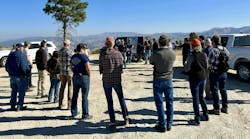Results of a survey of 63 utilities in North America entitled “Pole Fire 2019” has just been completed by members of the CIGRE Wildfire Mitigation Working Group and Exacter, Inc. of Columbus, Ohio. The goal of the survey was to explore what utility stakeholders believed about the origins, causations, impact, and cost of pole fires, as well as the strategies and methods being used to mitigate them.
Respondents were a mixed cross section of IOUs (27%), Rural Cooperatives (48%), Municipals (19%), and Canadian utilities (6%) ranging in size from 700 miles and under systems to overhead grids of more than 90,000 miles. The questions asked pertained to pole fire activity over the past 12 months.
“Perhaps the most surprising result of the survey for many readers will be what 68% of utilities cite as the primary root cause of pole fires. It’s not climate change, or even the weather. It’s partial discharge, leakage current, or flashover incidents from deteriorating overhead equipment,” states John Lauletta, Exacter CEO and member of the CIGRE Wildfire Mitigation Working Group.
“What was most interesting to us was that only 19% of the responding utilities had a specific program for preventing pole fires,” states Geoffrey Bibo, Exacter’s president.“That doesn’t mean that many of the root causes aren’t being addressed as part of other programs, however, it did reveal that pole fires and collateral damage from them are not singled out as an area of direct focus by more than 80% of the utilities surveyed.”
Sixty-three percent of respondents estimated the cost to repair a pole fire incident fell in the range of $10,000 to $20,000. This would include the cost to replace the pole, equipment, and installation labor. As we know from the wildfires that have been ravaging the west, the largest cost is not the repair, rather the collateral damage. 25% of the utilities responding reported that at least one pole fire incident led to collateral damage of some kind.
“Collateral damage doesn’t have to be an out of control wildfire -- it can be a small fire. It can impact just 2-3 homes or a number of vehicles, but even these types of collateral incidents can take the cost from $15,000 to $50,000, to $500,000 or more very quickly,” added Lauletta.
Lauletta and The CIGRE Wild Fire Mitigation Working Group will be circulating the data among its members as part of their effort to make recommendations to the industry on how utilities can better address the issue of wildfire prevention.
“There are lots of interesting insights in the survey on what utilities are doing to mitigate the various root causes,” concluded Lauletta. “It’s an issue Exacter has been addressing for a number of years because we address the primary root cause. I would encourage anyone in the utility industry to review this important survey and research.”
To receive a copy of the Pole Fire Survey, click here.


